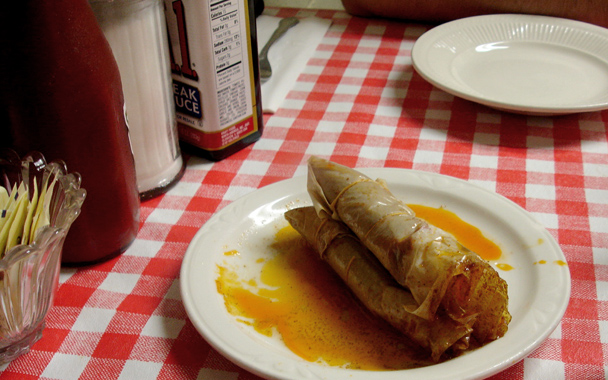The Mississippi Delta tamale is the Stonehenge of foods: No one is quite sure how a traditionally Hispanic dish wound up as a lunch counter favorite in these kudzu-choked river towns, but everyone’s got a theory. Accompanied by my friend Laurie, I drove my old Civic up the ragged edge of the Delta—the lush, humid plain between the Mississippi and Yazoo Rivers—stopping to try tamales of all shapes and sizes. Although we didn’t unravel the mystery, we sure got full.
Our first stop was the Confederate fortress city of Vicksburg, where Solly’s Hot Tamales occupies a brick storefront amid the shotgun houses and small casinos.
Founder Henry Solly rode the rails to Mississippi during the Depression, bringing with him a tamale recipe from California. He set up shop in 1939, peddling tamales for five cents a pair. Solly’s tamales are now $2.50 for three. Solly died at 100 in 1992 and today, Shane Rowland, his unofficially adopted great-grandson (it’s complicated), mans the ancient cast iron stove plucking missile-shaped tamales from a simmering enameled pot. (Delta tamales are boiled, not steamed like Hispanic tamales, which gives them a softer, finer texture.) Although Solly’s are barely bigger than a Hi-Liter, the cornmeal expands in your stomach, Rowland warned me. He should know—he once ate two dozen.
“I was pretty well bloated,” he said cheerfully. I unfolded the dripping corn shucks and tucked into juicy spiced cornmeal filled with Solly’s ground beef “chili.” They were delicious, but I stuck to two. There was a long road ahead.
After a two-hour drive north through the cotton fields of Highway 61, we walked into Doe’s Eat Place in Greenville with some trepidation. It was 8:30 at night on the wrong side of the tracks, and the crooked white cottage looked forbidding. But lo and behold, inside was what appeared to be tout le monde of Northern Mississippi, devouring steaks and pyramids of tamales on chipped platters. Tables of well-fed businessmen toasted with B.Y.O.B. Maker’s Mark like it was poker night at the judge’s house.
Many locals credit Doe’s founder, Dominick “Doe” Signa, with popularizing tamales among white Mississippians in the 1940s, having gotten a recipe from an African-American coworker. (Early Delta tamales were largely sold by black cart vendors.)
There’s no menu, so on the advice of a neighboring table I ordered a t-bone (phenomenal), and a half-dozen tamales. They came wrapped in string-tied parchment, resembling nothing so much as small, wet cigars. Billowing cumin-scented steam, they yielded under my fork as softly as cream cheese to reveal centers of salty, delectable ground beef.
“I’m pretty sure these are going to be my favorites,” I declared.
But then, the next morning, I met Shine.
Lawrence “Shine” Thornton of Maria’s Famous Hot Tamales has been rolling beef tamales in a freestanding kitchen behind his Greenville home since the mid-1980s. At 82, the former motor repairman is a touch unsteady, leaning on a rusted shopping cart he refers to as “my Cadillac,” but he still turns out garlicky, feather-light tamales. Looking dapper in a blue sailor’s cap, he served us on paper plates and nodded as we moaned our approval. The recipe came from a friend, who got it from an African-American acquaintance, who, Shine said, likely got it from Mexican migrant farm laborers in the early 20th century.
Shine has long been trying to send a gift of tamales to George W. Bush, but those darn security people won’t let them through.
“They burn them up!” he exclaimed.
President Bush, if you’re listening: You’ve got to try these tamales.
“Are you really from North Carolina!” marveled a lone elderly woman, spying my license plate as Laurie and I pulled into tiny downtown Greenwood, about an hour east of Greenville. It was 2 p.m., and the streets were post-apocalyptically empty, the old brick cotton warehouses standing vacant. But in the dim confines of the Crystal Grill, it could still be 1939. A genteel-looking couple lingered over coffee at a burnished wood table; a woman talked weather with the cashier as she waited for her take-out tamale order. Owner John Ballas, whose Greek-born uncle bought the restaurant nearly 80 years ago, gets his beef tamales from a Greenville tamale-maker and boils them with his family recipe spice mix. I ordered a half dozen, which were as big as corn dogs, by far the meatiest I’d tasted. I rounded out the meal with collards and a cool slick wedge of lemon icebox pie.



 Pinterest
Pinterest


